Developed from a weapon originally designed by a priest, of all people, in the Austro-Hungarian army, the Granatenwerfer 16 was a German WWI grenade thrower which bridged the gap between hand-thrown grenades and the light minenwerfers. Throwing a small grenade with a 400g (14oz) high explosive charge to a maximum range of about 300 meters (330 yards) , the Gr.W.16 with a practiced crew could maintain a rate of fire of 4-5 rounds per minute.
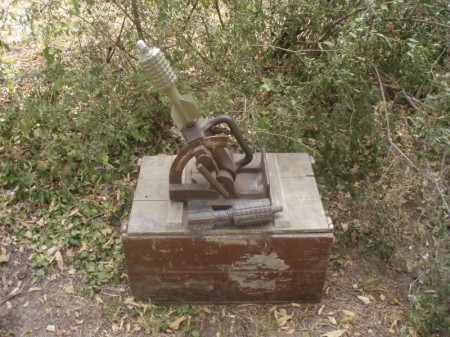
The Granatenwerfer 16 was a classic example of the spigot mortar type weapon. Rather than having a hollow barrel into which the projectile fit, it had a simple rod with a firing pin built in. The grenade it fired had a hollow center shaft, which fit onto the firing rod. To fire, a gunner (a 2-man crew, in practice) would first adjust the spigot rod to the correct angle for the desired range, depress the cocking collar until the firing pin was cocked, rotate the safety lever to the “safe” position, insert a fuse into a grenade (they were fairly sensitive impact fuses), slide the grenade onto the launcher, remove the safety pin, and fire the grenade by means of a lanyard pull.
The Gr.W.16 was particularly portable because of its light weight – the launcher itself weighted 31 pounds and the base plate an additional 48 pounds. Thus both parts could be easily carried across areas too confined, muddy, or otherwise impractical to drag a wheeled minenwerfer through.
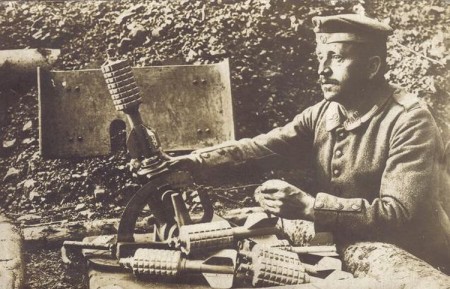
The grenade itself contained a special blank rifle cartridge (actually just a standard service round with the projectile removed), which provided the energy to launch – the granatenwerfer itself simply struck the cartridge primer to fire it.
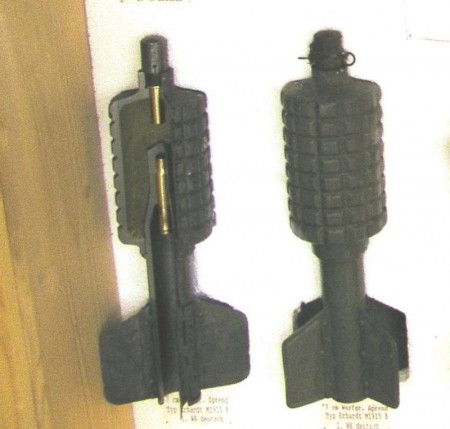
The Gr.W.16s proved to be popular and very effective weapons for the Germans. They had a high rate of fire, useful range, and reasonable effective detonation. They could be used in either direct or indirect fire applications – direct fire was used to fire at things like sentry posts, gun loopholes, and the like. When fired this way, the grenade fragments would fill an area roughly 5m wide and 50m long, while a round fired in a high angle trajectory would have a bursting radius of about 30 meters. Minimum high-angle range was 50 meters, to avoid endangering the firing crew.
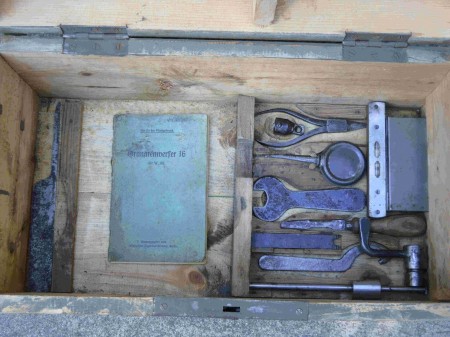
In terms of manufacturing, the Gr.W.16 was a very simple device, and easy to produce, with only a few moving parts and noting requiring the level of precision that a conventional barrel would need. This made it idea for production by companies like toy manufacturers, who had experience with casting relatively small parts to relatively loose tolerances.
A fellow on WarRelics.eu posted a number of pictures of a Gr.W.16, which I have copied here:
We also came across a copy of an original German manual for the device, which you can download:
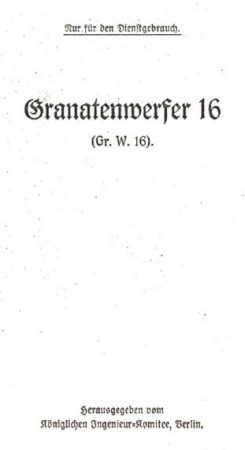

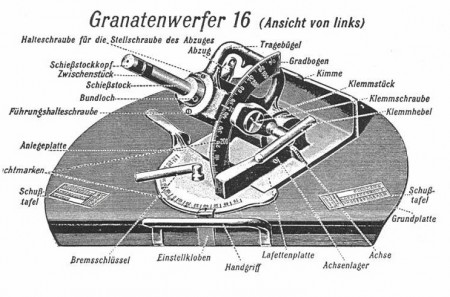
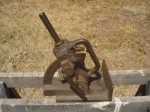
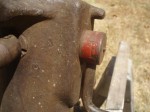
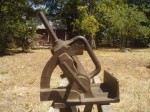
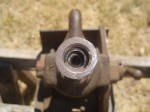
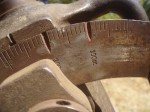
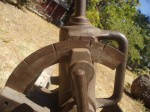
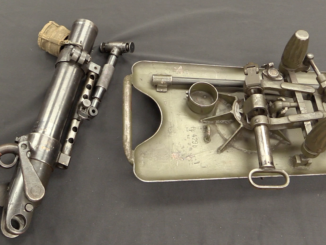

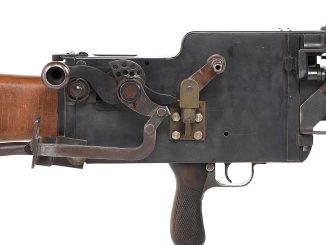
Very interesting, Ian. It’s amazing how simple it is. What would the legal hoops (if any) of making one be?
I think this is the “hoop” you need to be concerned with;
As can be seen here, under the NFA, “acquisition” encompasses “manufacture of”.
A non-firing replica would not fall under these restrictions, anymore than a “non-gun” reproduction of a Stg 44 or Thompson SMG would. However, note that some states (notably CA) prohibit even such “decorator” arms.
Depending on where you live, building a non-firing “display model” could be no big deal- or could end you up in court.
Myself, I do build non-firing replicas of all sorts of weapons. They’re 1/6 scale (2″=1′), made mostly out of plastic, and are scaled to go with my collection of 11 to 12-inch “G.I. Joe”- type action figures.
Yes, I’m an overaged geek. So sue me.
cheers
eon
In Britain, even making a “replica” is illegal for mundane subjects.
I’m not sure whether “replica” extends to the approximate shape, chewed out of a toasty, by child.
If you use inert grenades and don’t have completely self contained ammunition (could be done by having using a muzzle loader cap as the primer and having that attached to the frame instead of in the projectile) it would be exempt from the destructive device regulations similar to beer can mortars.
I just wasn’t sure if spigot mortars were considered destructive devices. If they are, all that means is a form needs to be filled out, the government paid it’s tax , and wait, just like any other destructive device.
if you are going to make a replica i would recommend making it a airsoft replica
use a co2 cartridge instead of the blank and make the grenades out of plastic that way i would think that you can avoid a lot of legal problems
I understand where you’re coming from, however, those of us who use these for reenacting have yet to find a State where the dummy rounds and modified propellant rounds are illegal.
Also, how would you adapt the Gr.W. to use CO without damaging or ruining the Gr.W.?
D’oh!!! (Banging head on wall)
I just realized you were talking about doing this if you were building a replica.
Sorry about that.
It would be interesting to see how this could be done. A weapon like this would be rather fun on the Air soft field!
The hand thrown lawn darts were banned. So an inert heavy lawn dart you’re chucking 300 meters is probably a bit tricky to get a permit for.
Lawn darts were marketed as a toy and were banned as a dangerous toy. A modern compound or cross bow is a much more dangerous weapon than the lawn darts, but they have (thankfully) not been banned in the US or even in countries which have much stricter firearms laws. However, they are not marketed as toys. I also don’t think replicas of Plumbatae(A Roman and medieval lead dart) or similar ancient dart weapons are prohibited anywhere.
It would be sort of difficult, as a plumbata is basically a “product-improved” short arrow (a lot like a crossbow quarrel) that just doesn’t happen to require a bow of any sort to launch it- just a good pitching arm.
Although I could see some jurisdictions classing it as a “martial arts” weapon, like shaken, etc., and getting a bit picky about where and how you could legally carry/transport it.
Re-enactors take note.
cheers
eon
Between this and this http://historicalfirearms.info/post/83954060926/ordnance-of-the-week-blanch-chevallier-grenade (does anyone know anything more about the design? The write up is pretty good, but I’m curious if it ever made it to the testing stage) This week has given me a sudden great interest in early grenade launchers.
It looks very much like it was inspired by the Greener Light Harpoon Gun;
http://www.imfdb.org/wiki/Greener_Light_Harpoon_Gun
Which was also based on the Martini-Henry action. The internal mechanism, with that heavy spring, though, looks more like a forerunner of one of Lt. Col. Blacker’s “spigot” mortar devices, like the Blacker Bombard;
http://en.wikipedia.org/wiki/Blacker_Bombard
Or the PIAT;
http://en.wikipedia.org/wiki/PIAT
It must be noted that British Army “grenadier” regiments used grenade dischargers going back to the flintlock era, like this Brown Bess-based “Hand Mortar”, circa 1760;
http://www.nam.ac.uk/online-collection/images/480/96000-96999/96547.jpg
So for the Royal Army, this would have been a natural idea, being an update of one of their old standbys.
Even in the 1700s, war was already becoming a fairly scientific affair. And there really is “nothing new under the sun”.
cheers
eon
@eon, thanks, I’d completely forgotten about the Greener Light Harpoon Gun.
And from what you said about the problems with rifle grenades it seems bizzare the British didn’t go with this design, especially as it apparently would have used their stocks of surplus Martini’s in production.
So this is a precursor of the French “Jet Shot” system?
This looks like the grandfather of the Blacker Bombard which was issued to only the Home Army after all other British weapons were lost at Dunkirk in 1940. Supposedly,this unloved beast was the ancestor of the British PIAT introduced in 1942. Projector Infantry Anti-Tank!)
Is there any evidence of any connectivity between these weapons and their originators/users?
The PIAT was also an unloved beast because it was too heavy and awkward to cock but did have a few advantages. There was no black-blast so it could be used to ‘rathole from room to room to house in close street fighting. Also, the heavy warhead could do for a Tiger (on a good day) whereas the US Bazooka was just a paint scraper.
I stumbled across a U Tube of one being fired and the projectile appeared to fly quite quickly and horizontally to a target about 100 metres away. What was the initial velocity and how does this compare with a US bazooka or german panzerfaust?
Cheers, TKerr
The Bombard and PIAT were both conceived by one Lt. Col. Blacker, who was a strong proponent of the “spigot mortar”. He also was involved in the RN’s development of the “Hedgehog” ahead-throwing anti-submarine mortar, which was basically a cluster of large spigots firing bombs the size of dairymen’s milk cans.
The MV of the PIAT wasn’t high, but neither was that of its rocket-powered and recoilless gun opposite numbers;
PIAT; 76 m/s
M1 “Bazooka”; 81 m/s
Panzerschreck; 110 m/s
Panzerfaust (recoilless gun); 30 m/s (PnzFt 30) to 85m/s (PnzFt 150) (numbers designate range in M)
The low velocity of the rocket launchers and (primitive) RCL gun was due to their propellant grains and powder charge being designed to be all burnt before the bomb left the muzzle, to avoid injuring the operator or his no. 2 with backblast. In the case of the Panzerschreck, there was a detachable “shield” to give the operator some protection in case the motor burned longer. Also, Panzerschreck crews usually wore their gas masks, both so they would have the protection of the goggles and face masks, and because the fumes from the solid rocket motor were decidedly unpleasant to breathe.
Keep in mind that since all of the above had hollow-charge warheads, velocity wasn’t all that important. A hollow charge will do about the same amount of damage at any impact velocity, unless you slam it into the target so hard and so fast that its front “cone” collapses before the base fuze can fire. This was a problem when HC rounds were used in tank or anti-tank guns.
In other words, the “projectors”, of all persuasions, were the ideal “launchpads” for HC bombs precisely because they didn’t send them downrange too fast. They hit and there was enough “dwell time” for the base fuze to fire, setting off the main filling. This was also true of HC AT rifle grenades, like the U.S./British M9/No. 85.
Sources;
Wikipedia
Hogg, Ian. Grenades & Mortars. New York; Ballantine, 1974.
Ley, Willy. Rockets, Missiles, And Space Travel. New York; Viking Press, 1951.
cheers
eon
This is too cool! How does this compare in firepower to say, an SKS grenade launcher? Also, since it’s a [nearly] solid rod instead of a tube, is it even possible to load this fast enough to overheat like a conventional mortar?
I can’t imagine that it could overheat – all the burning powder is pretty much contained inside the grenade, and not transferred to the launcher.
As for firepower, rifle grenades were commonly used in WWI, and I would assume that choosing to produce these rather than more rifle grenades would suggest that they were superior. Which makes sense – they would certainly have been much more accurate, at least unless the rifle were mounted in a fixed apparatus to allow repeatable aiming (which was done, but then you have something much bulkier than this)
Hogg (Grenades & Mortars) relates that rifle grenades were not popular with the various armies in WW1. First, because most at that time were “rodded” grenades, with a steel rod that went down the barrel as much as 12-14″. The sudden “gas check” when the column of gas from the fired blank round hit the end of the rod almost always resulted in a bulged barrel with repeated use.
Also, even with non-rodded grenades, like the French Vivien-Bessiere (also used by the AEF) and the British 2.5in Rifle Cup Discharger No. 1 (that fired the Grenade No. 36 aka “Mills Bomb” with a disc screwed to its filler plug in the base), the mass of the grenade threw a tremendous strain on the rifle due to recoil. Eventually, the stock came apart and the receiver ring generally cracked.
A special “reinforced” pattern of the SMLE was developed to deal with this, the “EY Rifle”;
http://lrdg.hegewisch.net/LRDG_images/EY_rifle.jpg
Note the wire bindings around the forestock. The designation “EY” is supposed to have either meant “EmergencY” (as in “don’t try to use it as a ‘shooting’ rifle unless you’re really in the fertilizer”), or due to it being conceived by one Edgar Youll (Hogg) or “Sir Ernest Youlle” (other sources). I don’t know who’s right.
I saw one of these rifles, with the “EY” mark on the receiver, at my local dealer about 20 years ago. That one, an SMLE No. 1 MK III*, also had wire wound around the stock wrist, just ahead of the receiver ring, and just ahead of the rear sight, five sets of windings in all, with the wire also carefully soldered together at the ends. Knowing what it was and what it may have gone through, I didn’t buy it; I wasn’t interested in a rifle that probably wasn’t safe to shoot.
About the same time I turned down a Ross Mk 1 .303in for $200- I think you can guess why. And yes, its bolt was assembled incorrectly. I showed the dealer the small problem with that.
cheers
eon
There was Russian Dyakonov Rifle Grenade Launcher
http://www.imfdb.org/wiki/Dyakonov_Rifle_Grenade_Launcher
developed in 1916, but no produced until 1928 which use the live rifle ammunition to propel grenade. It was similar in principle to blow-forward pistol, but there the moving element was grenade not barrel.
Here: http://www.battlefield.ru/soviet-rifle-grenade.html
is Russian article described Dyakonov launcher and drawings. The bullet go through bore which you can see in drawing described Граната ВГК-40 в разрезе
The French Vivien-Bessiere grenade worked on the same principle;
http://www.secondeguerre.net/images/articles/armes/fr/gr/schemagrenade.gif
One drawback to such grenades was training. While grenades using blank charges for launching only required a “safe space” a bit larger than the grenade launcher’s range (generally around 200 to 250 meters), the VB (and probably the Dyakonov as well) required a downrange safe space long enough to allow for the rifle bullet’s range. Which, at the angle of elevation used for grenade launching, would have been at least 2000 to 2500 meters, if not more.
cheers
eon
With the increasing sophistication of 3D-printing, I have always wondered what the market would be for reproduction weapons such as this rare German WW1 device.
I know barring the repeal of the Title II sections of the NFA it isn’t possible today for sales in the US, but if it were repealed, how many people would want to purchase working obsolete weapons such as this? I know I would of course if it was legal, but I’ve wondered what the market could be someday and what kind of historic weapons should or could be reproduced?
It looks like the only parts of the launcher that would need printing would be the graduated elevation dials, and they could be printed on ordinary paper and glued on.
For those authoritarians whose conceinces are sufficeintly guilty for them to fear ordinary people, this simple spigot should be a lot scarier than the plastic liberator pistol ever was.
I’m guessing that even if the only steel part was a nail for the firing pin, and the rest was made of wood, it would still have a longer service life than a printed plastic pistol.
A common misconception – new production machine guns are not transferable, but you can make all the new destructive devices (or SBRs, SBSs, and AOWs) you want, as long as you pay the tax and register them.
The PIAT used a spring to fire the projectile. On the one hand it had a low very low signature compared to the bazooka, on the other it was almost impossible to reload if the shooter was prone without giving themselves a hernia.
It was designed by a Hungarian priest named Vécer who sold his design to Rheinmetall. Because of its designer, it was also called “kleiner Priester” (little priest) or Priesterwerfer (priest launcher) by the German troops. Range 250 m, projectile mass 2 kg. Rheinmetall designer Carl Waninger mentions him in his (post WW2!) book.
To be honest, I am not sure what to make of “Granatenwerfer 16” (official name Granatwerfer 16) and the status of the Royal Engineers-Committee (Königliches Ingenieur Komitee) which I never heard of. But I am no expert in WWI.
Note that spigot mortars were also used during WW1 by other armies British Army used Toffee Apple mortar (official designation: 2-inch Medium Mortar), the French Army used Crapouillot mortar (Mortier de 58 mm type 2) and Russian Army used 20-мм бомбомет Лихонина обр. 1916 i.e. literally 20mm bomb-thrower designed by Likhonin model 1916.
(more info in Russian + drawing of mortar can be found here: http://ww1.milua.org/20lihonin.htm)
And the British “Toffee Apple” mortar was basically a copy of the German Krupp Model 1912 “Trench Howitzer”, which often gets overlooked by mortar enthusiasts because its name gets it confused with the “real” howitzers Krupp also made at the time.
The British version came about when a captured Krupp M1912 was sent back to the rear, and 100 copies were turned out (by Coventry Ordnance Works, IIRC) to give the Tommies something to shoot back with until more “orthodox” weapons could be deigned and produced. The end result, of course, was the Stokes mortar family, descendants of which are still with us today.
cheers
eon
The paper (doctoral dissertation) I mentioned in the comments to the 38cm Minenwerfer also has chapters about the Granatenwerfer 14, 15 & 16 and their ammunition. This text can be easily copied and translated with Google Translate, if you don’t understand German (or as I, understand it only partially).
http://ediss.sub.uni-hamburg.de/volltexte/2013/6126/pdf/Dissertation.pdf
The part about Granatenwerfers starts at page 369.
Correction: actually at page 368.
Hi all
This wasinvented by thenorvidgian Niels Aasen, wo also invented the personel mine, witch he called tke automatic soldier. He also invented the Morter witch he called a handgranade howitser.e made handgranades for the French, german, russians and the italians in 1. w W.
Great writeup, very interesting!
Hello everyone!
A friend of mine contacted me today and said I needed to checkout today’s featured weapon. Much to my surprise “Belching Bertha” was the weapon!!! Yup – the Granatenwefer 16 pictured here is mine.
This particular one was made by ‘Maschinenfabrik Alfred Wolff Berlin SW. 68’, Nr. 25254 (out of 70,000 made).
After reading the comments I thought I throw my 2 cents worth in. To help I’ve attached the poster’s name and comment(s) bracketed by “>> <<". I have done the same thing in regard to the actual article. >> Article – Granatenwerfer 16 on its transit case (without base plate)<< The crate in the picture is actually an old ammo box from WWII. It is close in shape to an actual transport case though. I'm still trying to source an original transport case. In reality the 'base plate' is attached. It is called a 'Lafettenplatte' which translates to 'Mount Plate/Base Plate'. The big plate, the one that's bent downward in the front, is a 'Bettung', 'ballast' - it is designed to provide a sturdier platform due to the kick and the bent front end helps keep it from moving backwards in recoil. If the Bettung wasn't used it was suggested that at least one sandbag be placed behind the butt-plate of the mount plate - this kept it in place. The confusion between the 'Lafettenplatte' and the 'Bettung' more than likely comes from the parts that make up the Bettung. While the 'Lafettenplatte' is a single piece the mortar mounts to the 'Bettung' is made of two primary parts - the 'der vorn umgebogenen Grundplatte' or 'the front bent base plate' and the 'Anlegeplatte' or 'investing plate' which is basically the horizontal angle plate. For the most part people do call the larger, ballast, plate the 'Base Plate' just because it's easier. In my own mind I try to keep these separate for reasons dealing with nomenclature to aid in research, cataloging and collecting. Some of us refer to them as "the small base plate and the large base plate". Now - to make it a lot more "interesting" there is a third base plate that is so rare it is one of the 'Holy Grails' of the Gr.W. collecting world and that's the 'Combat Plate'. I have only see pictures of the combat plate and both of them are in museums. The combat plate was designed to be lighter by removing 1/3 of the 'Bettung' on either side of the 'Anlegeplatte'. Believe it or not but I have copies of the original Reichspatent for both of these plates. >> Article – …insert a fuse into a grenade (they were fairly sensitive impact fuses)… << Correct. To add to this - the fuse was a two part fuse, a detonator and a fuse. The one used the most in the various Wurfgranate versions was the "Sprengkapsel Nr. 8". This was, and still is as far as I know, the most common detonator used in the military and mining industry. The 'Knallsatz' - detonating composition consisted of 28.5 grams of fulminant composition - I need to double check the amount - seems high. The composition was typically made of Silver fulminate (AgCNO) an highly explosive silver salt of fulminic acid. However, Mercury(II) fulminate, or Hg(CNO)2, was also used as the primary explosive. This one is highly sensitive to friction and shock and is mainly used as a trigger for other explosives in percussion caps and blasting caps. I hope I got that right, my German and chemistry aren't the best! >> Article – the launcher itself weighted 31 pounds << In reality the Gr.W.16 itself weighs 24kg (52.91 pounds). The Bettung weighs 16kg (35.27 pounds rounded up). The transfer case, with tools and spare parts, weighs 10kg (22.05 pounds rounded up). The Wurfgranate 15 weighs 1,85kg (4.08 pounds rounded up) >> Article – The grenade itself contained a special blank rifle cartridge (actually just a standard service round with the projectile removed), which provided the energy to launch – the granatenwerfer itself simply struck the cartridge primer to fire it. << There is a mystery around the Patronen (cartridges) used as the propellant rounds. It is know that these were designed as a system, named after it's creator and for the life of me I can't remember the name! Anyway - they were modified 7,92mm blank cartridge used in the Wurfgranate 15 and Wurfgranate 16. The system contained three types of propellant rounds that were distinguished by color - plain, red stripe and green stripe. The plain and red ones are the most common and their individual purposes are know, the green one is the mystery, no one seems to know what it's function was intended for. Also - the Wurfgranaten were shipped with the propellant round already pressed inside. >> Article – In terms of manufacturing, the Gr.W.16 was a very simple device, and easy to produce, with only a few moving parts and noting requiring the level of precision that a conventional barrel would need. This made it idea for production by companies like toy manufacturers, who had experience with casting relatively small parts to relatively loose tolerances. << Yes - the Gr.W. was a simple device and with each incarnation it got a bit more simple to make and use. There are only two different, documented, manufacturers of the Gratenwerfer 16, the Bing Brothers in Nürnberg and the Maschinenfabrik Alfred Wolff in Berlin. The Bing Brothers did make toys but I have seen no reference to toys made by Wolff. I have seen some of the Reichspatent submitted by Wolff and all seem to be of a machining and/or militaristic nature. If you have info linking Wolff to toys please let me know. >> Article – Note that the firing pin and cap are missing; this was typically done to “demil” the weapon. << Yes, this is true - however, it is perfectly legal to replace the missing throwing arm cap and firing pin with either originals or reproductions. Mine has a repro cap but an original firing pin (there were about three different types of pins used for different applications). I do know of a few Gr.W.16s out there that still have their original caps and pins but most are found without. >> Big Al – What would the legal hoops (if any) of making one be? << Big Al - These are perfectly legal to own with cap and pin in place. There is no special paperwork, or license, required to own them. It is complicated but due to design they are exempt. On the flip side it is illegal to own a live Wurfgranate. If for some reason it is illegal, and I've been given the wrong information, then there are several law enforcement officers, a member of Homeland Security and an attorney who use to be the AG for the state he's from that are also misinformed for they have all seen mine and have seen it fired and think it's cool. On a side note - the above mentioned attorney is a huge collector of fully functioning, full auto, German machineguns from WWI and WWII - if anyone would know it would be him; besides, he also owns a fully functioning Gr.W.16!!! I do know of a fully functional one that is for sale for $7,500 if anyone's interested. >> Eon – note that some states (notably CA) prohibit even such “decorator” arms. << Eon - not sure what to say about this... The best collection of privately owned Gr.W. items, including a working Gr.W.16, lives in CA, he is the guy who got me an original firing pin. There is also a reenactment group in CA that own two as a group, and have access to a third one that belongs to a member, and all three are fully functional. One of the comments on this thread mentioned a video showing one being used - the video was made by this reenactment group using one of the unit owned Gr.W.16s. >> Nobody – If you use inert grenades and don’t have completely self contained ammunition (could be done by having using a muzzle loader cap as the primer and having that attached to the frame instead of in the projectile) it would be exempt from the destructive device regulations similar to beer can mortars. << While this might be true nobody in their right mind would use an inert Wurf!!! These things are pushing prices into the $200 (for a crappy example) to $800 (for a virtual mint example) range and it will get worse as the Centennial continues. The attorney I previously mentioned had 25 steel reproductions made of the Wurf.15 back in the mid to late '80s. Through use he has lost most of them (buried themselves) and only has two left. I have spoken to several machine shops about reproducing some but they would really rather not - mainly due to issues caused by 9/11. One did shoot me a bid - $600 each. At that price I could buy a junky original and play with it. Most of us use some sort of alteration to play with our Gr.W.16s. For mine I have had a couple of steel shot-sleeves made using military grade steel rods. Basically these are like small rifle/shotgun barrels that were made to fit over the spigot/throwing arm. Halfway up the shot-sleeve the whole was drilled to fit a shotgun shell (one is for a 12 gauge shotgun shell and the other a 12 gauge shotgun shell). The charges are made using shotgun shells with the shot and gunpowder removed and filled with a little over 30 grains of 1F black powder and wading. The shotgun shell is inserted into the shot-sleeve and then the shot-sleeve is placed over the spigot/throwing arm. Once in place a dummy round, made of PVC and foam rubber, is placed over the shot-sleeve and then the shotgun shell is fired the same way an original was. BTW - we can get the dummy rounds to go 100 meters plus. >> Lars – The hand thrown lawn darts were banned. So an inert heavy lawn dart you’re chucking 300 meters is probably a bit tricky to get a permit for. << Lars - if you are comparing the dart to an inert original Wurf you do not need a permit to own an inert original. It is also perfectly legal to make dummy rounds that actually explode. I'm actually working with a pyrotechnic company that specializes in fireworks and other pyro devices for movies, stage, concerts, etc. to perfect dummy rounds for use during the day and at night. >> Nick – Between this and this http://historicalfirearms.info/post/83954060926/ordnance-of-the-week-blanch-chevallier-grenade (does anyone know anything more about the design? The write up is pretty good, but I’m curious if it ever made it to the testing stage) This week has given me a sudden great interest in early grenade launchers. << Nick - I'm not following you...what do you mean by "...but I’m curious if it ever made it to the testing stage"? You mean the Gr.W.16, the Wurfs or grenades? >> Thomas Kerr – I stumbled across a U Tube of one being fired and the projectile appeared to fly quite quickly and horizontally to a target about 100 metres away. << Thomas - are you referring to this one? http://www.youtube.com/watch?v=HOEmzqO5HTU&feature=related If so - this is the reenactment group I mentioned above. You can clearly see the guy placing a shot-sleeve on the spigot and then a dummy round. Those rounds were actually going over 100 meters. >> Thomas Kerr – What was the initial velocity and how does this compare with a US bazooka or german panzerfaust? << I don't have the data in front of me for this but it did depend on type of Wurf used, type of propellant round, etc. >> James P – Also, since it’s a [nearly] solid rod instead of a tube, is it even possible to load this fast enough to overheat like a conventional mortar? << James - not sure about this but the shot-sleeve and spigot can, and do, get hot enough to make you swear!!! The biggest problem is the carbon buildup created by the shotgun shell and dummy round on the inside, and outside, of the shot-sleeve as well as on the spigot/throwing arm. After a couple or so firings you need to buff these areas with emery cloth. Emery cloth was one of the items originally issued as part of the tool kit in the Gr.W.16 transport case. >> Ian McCollum – I can’t imagine that it could overheat – all the burning powder is pretty much contained inside the grenade, and not transferred to the launcher. << Ian - see above. ;-) >> Ian McCollum – As for firepower, rifle grenades were commonly used in WWI, and I would assume that choosing to produce these rather than more rifle grenades would suggest that they were superior. Which makes sense – they would certainly have been much more accurate, at least unless the rifle were mounted in a fixed apparatus to allow repeatable aiming (which was done, but then you have something much bulkier than this) << You are correct Ian - these are a lot more accurate. >> JPeelen – To be honest, I am not sure what to make of “Granatenwerfer 16″ (official name Granatwerfer 16)… << JPeelen - Sorry but this is a BIG issue with me. The 'official name' was not, and is not, 'Granatwerfer 16' but is 'Granatenwerfer 16'. Let me explain.... The correct spelling, during WWI, was 'Granatenwerfer'. Spelling it as 'Granatwerfer' during WWI was more of a slang term but became the correct spelling at some point after the war. No one I've spoken to really understand why unless it has something to do with the changes made to the German language during the '20s and '30s. Admittedly I have run across a handful of primary sources, about 4, such as a trench sign and postcards from Germany - that say "Granatwerfer"; the trench sign actually says "Granatwerferstand 6". Again, trench signs and postcards were not known for their accuracy in spelling unless it was critical. However, in looking at primary sources, such as military manuals, legal documents, Reichspatents, manufacturing forms, labels on the Gr.W.s, etc. it becomes obvious which spelling is correct. Following is a partial list of primary documents using 'Granatenwerfer' ithout any hint of the other. Reichspatent Nr. 303XXX; Reichspatent Nr. 301XXX; Reichspatent Nr. 321XXX: Minen- und Granatenwerfer; Schweizerische Patentschrift Nr. 87XXX: Unterlegplatte für Granatenwerfer; These documents are being hunted down in the national archives in Germany as well as a couple of other archives in Germany. Granatenwerfer 15, Königliches Ingenieur-Komitee, Berlin 1915; Granatenwerfer 16, Königliches Ingenieur-Komitee, Berlin 1916; Inhaltsverzeichnis: Zinc contents plates attached to the inside of the transport case; Patronen box for the propellant rounds; Official military/field manuals; & the manufacturer's plate attached to the Gr.W. 16 I personally own. I find it rather odd that if 'Granatwerfer' was the correct way to spell it - at that time - and taking into account the German notoriety for being exact, how would the government and military allow such blatant misspelling on legal documents, military issued manuals and information from the manufacturers? Then again, perhaps someone forgot to pass along the direct orders from the Generalstabs des Feldheers in regard to the spelling..... >> JPeelen – …and the status of the Royal Engineers-Committee (Königliches Ingenieur Komitee) which I never heard of. << Yes - the K.I.K. did exist and, IIRC, was started around 1716. If I'm not mistaken the original name was 'Königlich Preußischen Ingenieur-Komitees'. It was a board made up of military and non-milary scientists, engineers and the like. Their sole purpose was to review items brought before the military as proposed weapons, ammo, etc. They were to assess the military value of the item, how hard it would be to manufacture, how hard to use, how good it was and the list goes one. If the item got a good review it was pushed up the chain of command within the military for final determination. Most of their documentation was destroyed, can't remember how, but there are write-ups about this organization on the internet - all in German. I'm attempting to get copies of the reviews for the Gr.W.15 and Gr.W.16 but so far no luck. >> Daweo – Note that spigot mortars were also used during WW1 by other armies British Army used Toffee Apple mortar (official designation: 2-inch Medium Mortar), the French Army used Crapouillot mortar (Mortier de 58 mm type 2) and Russian Army used 20-мм бомбомет Лихонина обр. 1916 i.e. literally 20mm bomb-thrower designed by Likhonin model 1916. << Daweo - unless I'm misreading all of the information about these mortars they are all 'tube' mortars - the basic kind used by most of the armies during the war. The rule of thumb I was told in order to tell the difference is this "if any part of the projectile fits, or goes, INSIDE the mortar it is NOT a spigot mortar. If all the projectile fits OVER the mortar it's a spigot." Basically - if the projectile is 'male' it's a tube, if 'female' it's a spigot. Hope that makes sense. >> Euroweasel – The paper (doctoral dissertation) I mentioned in the comments to the 38cm Minenwerfer also has chapters about the Granatenwerfer 14, 15 & 16 and their ammunition. This text can be easily copied and translated with Google Translate, if you don’t understand German (or as I, understand it only partially). << Euroweasel - are you referring to the dissertation titled 'Die Entwicklung des Granatwerfers im Ersten Weltkrieg Die Entstehung eines neuartigen Waffentyps als Reaktion auf die Bedingungen des Stellungskrieges'? If so, I'm working with this guy on a Gr.W. project. He is looking at having the dissertation turned into a book to be published by the German military. He is encouraging me to go further in my Gr.W.16, and Wurf, research and have it published as a book as well. Anyway...sorry for taking up so much time and space. I hope you found this information useful or at least helpful. If any of you have further questions or comments, or have information to pass along - please don't hesitate to let me know. Cheers! Larry
Yes, that’s the dissertation I was talking about. It seems to be a pretty comprehensive source. I hope that his and yours book project both come true.
Well…I’m trying. It’s going slow and I tend to get lost in the details so the additional research slows me down.
The guy in Germany is shooting for 2015 though.
Larry, many thanks for these excellent explanations.
Glad to be of service.
Just two cents worth on California and firearms. True, the actual written law in California is monumentally stupid, but the real problem is the discretionary powers of the Office of the Attorney General which can essentially outlaw any weapons type by decree. All it will take is a TV special on “Mortars in our Midst” or some such and a politically ambitious AG (Is there another kind?} and as Senator-for-life Di-Fi says “Turn ’em in Mr. and Mrs. America”. True, after many years in court and bankrupting yourself to pay for the lawyers you may well win your case but you will still be forever branded by the state and the media as a “Racist, Homophobic, Rightwing Militia, Domestic Terrorist” with an arrest record that will be put in every available database and dog you for the rest of your life. I’m not saying don’t do it, just do it with your eyes open and a Plan B worked out ahead of time. Wafa Wafa Wasara Wasara.
Well said!!!
I do know that the reenactment group on CO only use their Gr.W.16s on private property and the events aren’t open to the public.
Also, the follow specific guidelines in the manufacturing of the dummy rounds and propellant rounds.
I guess I need to consider myself lucky in this regard living in Kansas. We have very lenient firearms/weapons law. In fact, our Governor just signed a law nullifying all Federal firearms laws that go against our State ones. We are even able to openly carry a side arm fully loaded with one in the chamber.
The blank round was it’s only source of propellant was it, hmmm… Here’s another sort of version,
http://en.wikipedia.org/wiki/Hedgehog_(weapon)
British from WW2
Handy, short range weapons these spigot designs…
The longer range mortar has a barrel because you but extra propellant around the tail pipe, more than you could fit inside it for the same size, which in a spigot design it would need to be to work, without a barrel to catch the gas from propellant on the outside sort of thing.
You’re right! The hedgehog looks like a spigot mortar on steroids!!!
One thing I forgot to mention.
The Gr.W.16 was being considered, and tested, by the US military for addition to our arsenal of toys.
Every Gr.W.16 I’m aware, here in the US, that has its original transport case was one of the samples brought back to the US for testing. Stenciled on the backs of the crates are the identification marks given to them by the US government. Those transport crates are usually in great condition.
Hi again, I am really unable to understand how you get those relics in N. America… ; over here you may be lucky if you find one under the glaciers in the Alps where they were used !!
Perhaps I can help with this Normann….
All of the Gr.W.16s I’m aware of here in the US got here by one of four methods – bring back by a unit; given by the Government as a “thank you” for money raised for the war effort (usually given to communities or organizations); brought here by the US Dept. of Ordnance (for testing and evaluation) and then through direct purchase from someone located outside the US.
The Gr.W.16s that are ‘complete’ – transfer case, tools, spare parts, etc. – are typically the ones brought here by the US Dept. of Ordnance and sold when no longer needed.
Most are just the Gr.W.16 by itself, with or without firing pin and/or nose cap, and came from any combination of the above.
As for mine, I know exactly where it came from, it came from a VFW (Veterans of Foreign Wars) Post in the north eastern US that closed down. There were three WWI units associated with the VFW Post so I’m not 100% sure which one brought it back. On a side note – along with the Gr.W.16 I received an Austrian helmet that was shipped to the Western Front in the last months of the war and it is even camouflaged! This helmet was brought back by a member of the unit that brought the Gr.W.16 back.
Following are some links to some photos.
This link shows the stenciling applied by the US Dept. of Ordnance to the back of the Gr.W.16 transport crates.
http://i97.photobucket.com/albums/l236/Correus/USStencils.jpg
This link shows the Gr.W.16 I own – “Belching Bertha”.
http://i97.photobucket.com/albums/l236/Correus/268fcba9-5f8a-46c9-b005-723c0e0bfbe0.jpg
And for “grins-and-giggles” here is a link showing the Austrian helmet.
http://i97.photobucket.com/albums/l236/Correus/AustrianM17.jpg
Can I simply say what a relief to uncover
somebody who actually understands what they are discussing over the internet.
You certainly realize how to bring an issue to light and make it important.
More and more people need to look at this and understand this side of the story.
I was surprised that you aren’t more popular given that you certainly have the
gift.
You could definitely see your expertise in the article
you write. The world hopes for even more passionate writers such as you who aren’t afraid to mention how they believe.
All the time follow your heart.